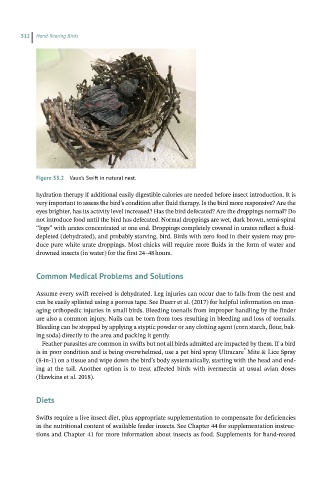Page 515 - Hand rearing birds second
P. 515
512 Hand-Rearing Birds
Figure 33.2 Vaux’s Swift in natural nest.
hydration therapy if additional easily digestible calories are needed before insect introduction. It is
very important to assess the bird’s condition after fluid therapy. Is the bird more responsive? Are the
eyes brighter, has its activity level increased? Has the bird defecated? Are the droppings normal? Do
not introduce food until the bird has defecated. Normal droppings are wet, dark brown, semi-spiral
“logs” with urates concentrated at one end. Droppings completely covered in urates reflect a fluid-
depleted (dehydrated), and probably starving, bird. Birds with zero food in their system may pro-
duce pure white urate droppings. Most chicks will require more fluids in the form of water and
drowned insects (in water) for the first 24–48 hours.
CommonMedicalProblemsand Solutions
Assume every swift received is dehydrated. Leg injuries can occur due to falls from the nest and
can be easily splinted using a porous tape. See Duerr et al. (2017) for helpful information on man-
aging orthopedic injuries in small birds. Bleeding toenails from improper handling by the finder
are also a common injury. Nails can be torn from toes resulting in bleeding and loss of toenails.
Bleeding can be stopped by applying a styptic powder or any clotting agent (corn starch, flour, bak-
ing soda) directly to the area and packing it gently.
Feather parasites are common in swifts but not all birds admitted are impacted by them. If a bird
®
is in poor condition and is being overwhelmed, use a pet bird spray Ultracare Mite & Lice Spray
(8-in-1) on a tissue and wipe down the bird’s body systematically, starting with the head and end-
ing at the tail. Another option is to treat affected birds with ivermectin at usual avian doses
(Hawkins et al. 2018).
Diets
Swifts require a live insect diet, plus appropriate supplementation to compensate for deficiencies
in the nutritional content of available feeder insects. See Chapter 44 for supplementation instruc-
tions and Chapter 41 for more information about insects as food. Supplements for hand-reared

